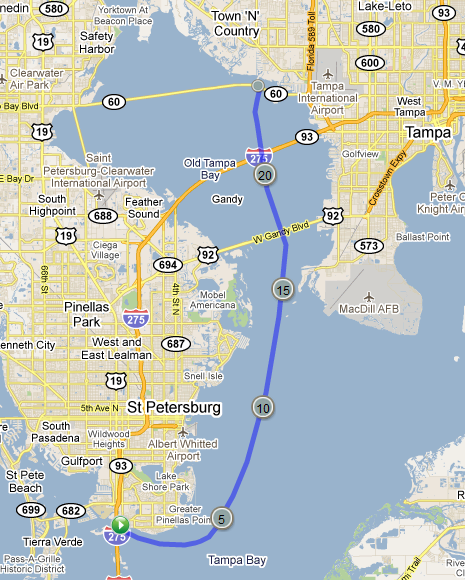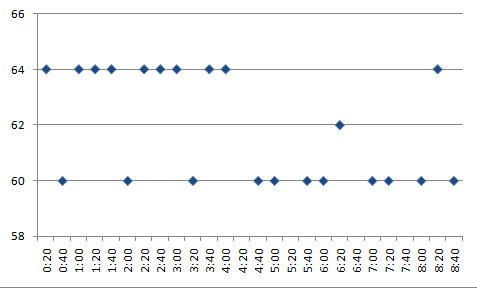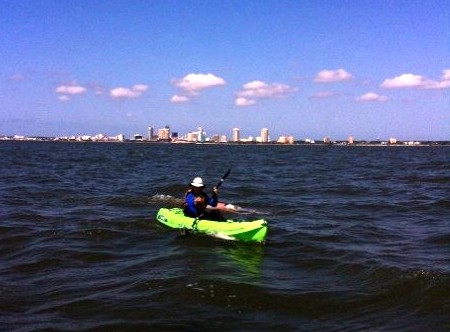Race Report: Tampa Bay Marathon Swim
Part 1: “Ultra”
If 10K is a “marathon swim,” what is 24 miles?
First, it’s different physiologically. In a 2-2.5 hour 10K, you’re still within the range of your pre-race glycogen stores (perhaps topped off with a couple mid-race feedings). Which means it’s possible to swim at near-threshold pace for the entire swim. In a 24-mile swim, you burn through not only your entire cache of muscle glycogen (perhaps 1,500 calories), but you’re burning through more calories per hour than you can possibly consume. Which means you must start metabolizing fat - a plentiful but less rapidly mobilized energy source - and swim at a substantially slower pace.
Even more important, a 24-mile swim is different psychologically. I’m thinking of two big issues here. First, failure is a distinct possibility, even for the best swimmers. Seasickness, digestive problems, hypothermia, tide changes - all can potentially end a swim. DNF’s do happen in 10Ks - but in a 24-mile swim, you’re truly at the mercy of the swimming gods, no matter who you are.
A swim this long is almost inevitably a struggle. There will be dark phases, and you can’t avoid them. You’re standing on the beach before the start, staring out at the water, and you know what’s coming. Maybe not the specifics of it… but you know there will be pain and doubt and frustration and possibly thoughts of giving up - but that you must try to push through them - to endure. This simply isn’t comparable to a 4-5 loop 10K (not to mention any pool race).
In the running world, distances longer than marathons are called “ultra.” But I’m not sure that communicates the quantum leap of going from 10Ks or a river-assisted 10-mile swim… to 24 miles.
Part 2: The Team
Without a team, a 24-mile swim doesn’t happen. Simple as that. And the swim’s success - it’s efficiency - depends on the quality of the team. Long swims are isolating experiences: A swimmer and his thoughts. But there’s an irony: The longer the swim, the more you utterly depend on your support team.
So any discussion of my experience in Tampa Bay must begin with my team.

The Team (L-R): Kathy, Carl, Pat, Michael, Kim... Frankland Bridge in the distance. (Photo Credit: Distance Matters)
It’s tough to overstate how fortunate I was.
- Captain: Pat, a retired Coast Guard officer and total pro with a nautical chart. Pat plotted a perfect line without LORAN, radar, or GPS. Just line-of-sight and a whole lotta skill.
- First Mate: Pat’s 12-year old son Michael, whose youthful curiosity and positive energy were exactly what I needed in the swim’s darker moments.
- Paddler (kayak): Kathy - my eyes and ears; my source of nourishment and encouragement; my only contact with the “outside world” for 9 hours. Kathy paddled 24 miles nonstop in 85+ air temperature and full sun. And she did it calmly, unflinchingly.
- Paddler (SUP): Kathy’s husband, Carl. More of a roving escort, but still a comforting presence. Rising above the water like Poseidon. No doubt, Kathy appreciated having someone to talk to during her marathon paddle!
I’m grateful to them all.
Part 3: The Data
Since Ron Collins’ pioneering swim in 1998 (9 hours, 52 minutes) through last year (2010), there were 149 solo entrants in the annual race. Of those 149 swims, 70 were DNF’s - they didn’t finish the full 24 miles. That’s a success rate of 53%. By comparison, over the same time period, 90% of MIMS entrants have successfully rounded Manhattan (239 of 266, not including those who withdrew before the event).
A few stats for 2011 (some actual, some approximate):
- water temp: 80F
- air temp: 70F (low) to 88F (high)
- wind speed: 15 mph (morning) to calm-ish (afternoon)
- calories consumed: 2,800
- calories burned: 5,000+
- fluids consumed: 320 oz (9.5 liters)
- strokes taken: 33,500 (a few on my back, for various reasons)
- pace per mile: 22:27
Re: the detours at each bridge, that’s because certain portions of those bridges are too low for the boat to pass under. Specifically, the parts crossing over the shortest path to the finish. So the boat went around to find higher clearance, while my kayaker and I went under.
Splits
First, the splits. Splits, of course, are in the form of [time / distance]. I got times from the GPS timestamps, and I got distances by using mapping software to calculate the length of each straight-line segment in the course taken by our excellent pilot. Here are the results:
| time | location | total time | total dist | split time | split dist | pace |
|---|---|---|---|---|---|---|
| 7:17 | start | 0:00 | - | - | - | |
| 8:00 | 14 St S | 0:43 | 1.7 miles | 0:43 | 1.7 miles | 25.6 min/mile |
| 8:20 | Bay Vista Rec Ctr | 1:03 | 2.5 | 0:20 | 0.8 | 25.2 |
| 8:51 | turning North | 1:34 | 3.8 | 0:31 | 1.3 | 24.0 |
| 9:29 | Lewis Blvd, Coq.Key | 2:12 | 5.5 | 0:38 | 1.7 | 22.3 |
| 10:47 | St. Pete Pier | 3:30 | 8.9 | 1:18 | 3.4 | 22.9 |
| 11:57 | Venetian Isles | 4:40 | 11.8 | 1:10 | 2.9 | 24.0 |
| 12:45 | Weedon Island | 5:28 | 13.6 | 0:48 | 1.8 | 26.7 |
| 13:54 | Gandy Bridge | 6:37 | 16.3 | 1:09 | 2.7 | 25.5 |
| 15:14 | Frankland Bridge | 7:57 | 19.7 | 1:20 | 3.4 | 23.3 |
| 16:16 | finish | 8:59 | 22.4 | 1:02 | 2.7 | 23.1 |
Lots of interesting stuff here! I could have told you:
- I was absolutely flying through about the St. Petersburg Pier - though my actual progress was slowed in the first 4 miles by a 12-knot headwind and relentless chop.
- The segment from St. Pete Pier to the Gandy was tough, both physically and mentally. There’s nothing to see and you think the bridge will never come. This is where the demons rise up from the depths (well, actually Tampa Bay is pretty shallow) - and you must beat them back!
- I got a second wind after the Gandy, and another one after the Frankland. Also the flood tide was nearing its apex around this time.
I could have told you all these things, but I don’t need to - it’s all there in the data.
Speaking of the flood tide, here’s what the current looked like at the Frankland Bridge that day:
So the flood tide maxed out at 5:08pm - 52 minutes after I finished. Those under the bridge at that point were getting a 0.23 knot push - not much, but better than nothing (about 7 meters per minute).
The data also tell you things you didn’t know. For example, it seems we managed to shave 1.6 miles off the official length of the course. Did I mention my pilot is a genius?
Nutrition & Hydration. Nailed it. 311 calories and 36oz of fluids per hour. Maxim at the :20 and :40; Perpetuem at the hour. Advil at 5:20 and 7:40.
Down-time. Because I wasn’t in a close race, I took pretty leisurely feeds - especially in the dark phase between St. Pete and the Gandy. It was comforting to exchange a few words with Kathy. I didn’t ask Kim to time my feeds, but she estimates I averaged about 30 seconds per. Over 26 feeds, that’s 13 minutes of down-time. If I reduced my feeds to 10 seconds, I’d save 8 minutes, 40 seconds - or about 600m of swimming. In a race like MIMS, that could be decisive.
Part 4: Hail of Bullets
20 minutes at a time. In marathon swimming as in life, projects that seem impossibly large can be reduced to a series of smaller, achievable tasks. Don’t think about swimming for 9 hours; think about swimming for 20 minutes - and then rewarding yourself with a tasty drink. Rinse, repeat. My feeds were refueling stops (104 calories each), but also a destination - something to look forward to.
Discomfort maintenance. A 24-mile swim is bad enough. Sunburn, chafing, saltwater mouth, and even seasickness - all are avoidable problems. The first three may not be swim-enders, but they certainly affect how you’ll feel the next day. Sunscreen, grease, mouthwash, and ginger - they are your friends.
Coppertone and Banana Boat probably won’t cut it. It doesn’t matter if it’s SPF 100 if it’s only waterproof for 2 hours. I used Solrx (8-hour waterproof) and it worked like a charm. Don’t forget the bottoms of your feet!
And Body Glide definitely won’t cut it (for 2+ hour swims). I use vaseline and lanolin in a 50/50 mixture.
Marine life. I heard reports of dolphins, but alas, I wasn’t so lucky. I had fish brush up against my legs every so often - harmless but definitely startling. And I had an unfortunate dust-up with a bed of oysters. Rounding Pinellas Point we were surprised by some sudden shallows. I took a quick glance at my lacerated hand… and hoped the sharks wouldn’t be next.
15 minutes after the start:
Flavia Zappa. Truly, the story of the day. She’s entered TBMS as a solo for the past seven years. 2005 - DNF at the Pier (7 hours). 2006 - DNF between the bridges. 2007 - another DNF. 2008 - DNF at the Pier. 2009 - DNF after rounding the Point. 2010 - DNF at the Gandy (12 hours).
2011 - finished in 15:10. A new course record for endurance! That’s just incredible, folks. Is there anything more important in marathon swimming than persistence and stubbornness? She’s got ’em in spades. Congrats, Flavia!
Part 5: Wrap-Up
A few good links:
- Official results at DistanceMatters.com.
- An item at the Daily News of Open Water Swimming
- A great segment on last night’s local news in Tampa.
- Photo albums on official Facebook page: Part 2.
Thanks to Ron and Rebecca Collins for organizing a memorable weekend.
Coming up in 7 weeks: MIMS.







